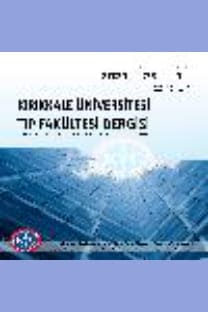Memede Hipertrofik Skar
Keloid ve hipertrofik skarlar, ilgili hekim için son derece zorlu bir durum arzetmekte olup kısaca abartılı yara iyileşmesi olarak tanımlanabilir. Bu makalede memeden fibroadenom eksizyonu sonrası 5. yılında insizyon skarı lokalizasyonunda keloid oluşan ve meme ultrasonografisinde skar dokusu arkasında multikistik-adenomatöz doku rapor edilmesi üzerine lezyonun eksize edildiği bir olgu sunuyoruz. Keloid, bir kez oluşmasının ardından tedaviye son derece dirençli ve rekürrense yatkın olduğundan, silikon ile kaplama, basınçlı pansuman ve kortikosteroid enjeksiyonu gibi birinci basamak tedaviler dikkatle değerlendirilmelidir. Keloidin cerrahi olarak çıkarılması ise, diğer tedavi metodlarıyla kombine edilmediği takdirde rekürrens açısından yüksek risklidir. Burada sunulan olgu ışığında, eski skar alanlarında yeni oluşan keloid varlığında, skar dokusunun ardında yara gerginliğini artıran bir patolojinin akılda tutulmasının faydalı olacağı görüşündeyiz.
Anahtar Kelimeler:
Keloid, skar gerginliği, fibrokistik meme
Pages 43-45
Keloids and hypertrophic scars represent an exuberant healing response that poses a challenge for physicians. (1). We present a case of keloid formation on a surgical site 5 years after surgical excision of fibroadenoma from breast. Breast ultrasonography revealed multicysticfibroadenomateuse tissue behind the scar area and surgical excision was performed. Once established, however, keloids are difficult to treat, with a high recurrence rate regardless of therapy. Evidence supports silicone sheeting, pressure dressings, and corticosteroid injections as first-line treatments. Surgical removal of keloids poses a high recurrence risk unless combined with one or several of these standard therapies. In the light of our case we think that, a pathology which incease scar tension must be kept in mind when new onset keloid on an old scar is seen.
Keywords:
Keloid, scar tension, fibrocystic breast,
___
- 1. Juckett G, Hartman-Adams H. Management of keloids and hypertrophic scars. Am Fam Physician. 2009; 80(3): 253-60.
- 2. Gauglitz GG, Korting HC, Pavicic T, Ruzicka T, Jeschke MG. Hypertrophic scarring and keloids: pathomechanisms and current and emerging treatment strategies. Mol Med. 2011; 17(1-2): 113- 25. doi: 10.2119/molmed.2009.00153. Epub 2010 Oct 5.
- 3. Avram MM, Tope WD, Yu T, Szachowicz E, Nelson JS. Hypertrophic scarring of the neck following ablative fractional carbon dioxide laser resurfacing. Lasers Surg Med. 2009; 41(3): 185-8. doi: 10.1002/lsm.20755.
- 4. Shetty N, Malaviya RK, Gupta MK.Management of unilateral masseter hypertrophy and hypertrophic scar-a case report. Case Rep Dent. 2012; 2012: 521427. doi: 10.1155/2012/521427. Epub 2012 Jul 10.
- 5. Ogawa R, Akaishi S, Huang C, Dohi T, Aoki M, Omori Y, Koike S, Kobe K, Akimoto M, Hyakusoku H. Clinical applications of basic research that shows reducing skin tension could prevent and treat abnormal scarring: the importance of fascial/subcutaneous tensile reduction sutures and flap surgery for keloid and hypertrophic scar reconstruction. J Nippon Med Sch. 2011; 78(2): 68- 76.
- 6. Pai VB, Cummings I. Are there any good treatments for keloid scarring after sternotomy? Interact Cardiovasc Thorac Surg. 2011; 13(4): 415- 8. doi: 10.1510/icvts.2010.264887.
- ISSN: 2148-9645
- Yayın Aralığı: Yılda 3 Sayı
- Başlangıç: 1999
- Yayıncı: KIRIKKALE ÜNİVERSİTESİ KÜTÜPHANE VE DOKÜMANTASYON BAŞKANLIĞI
